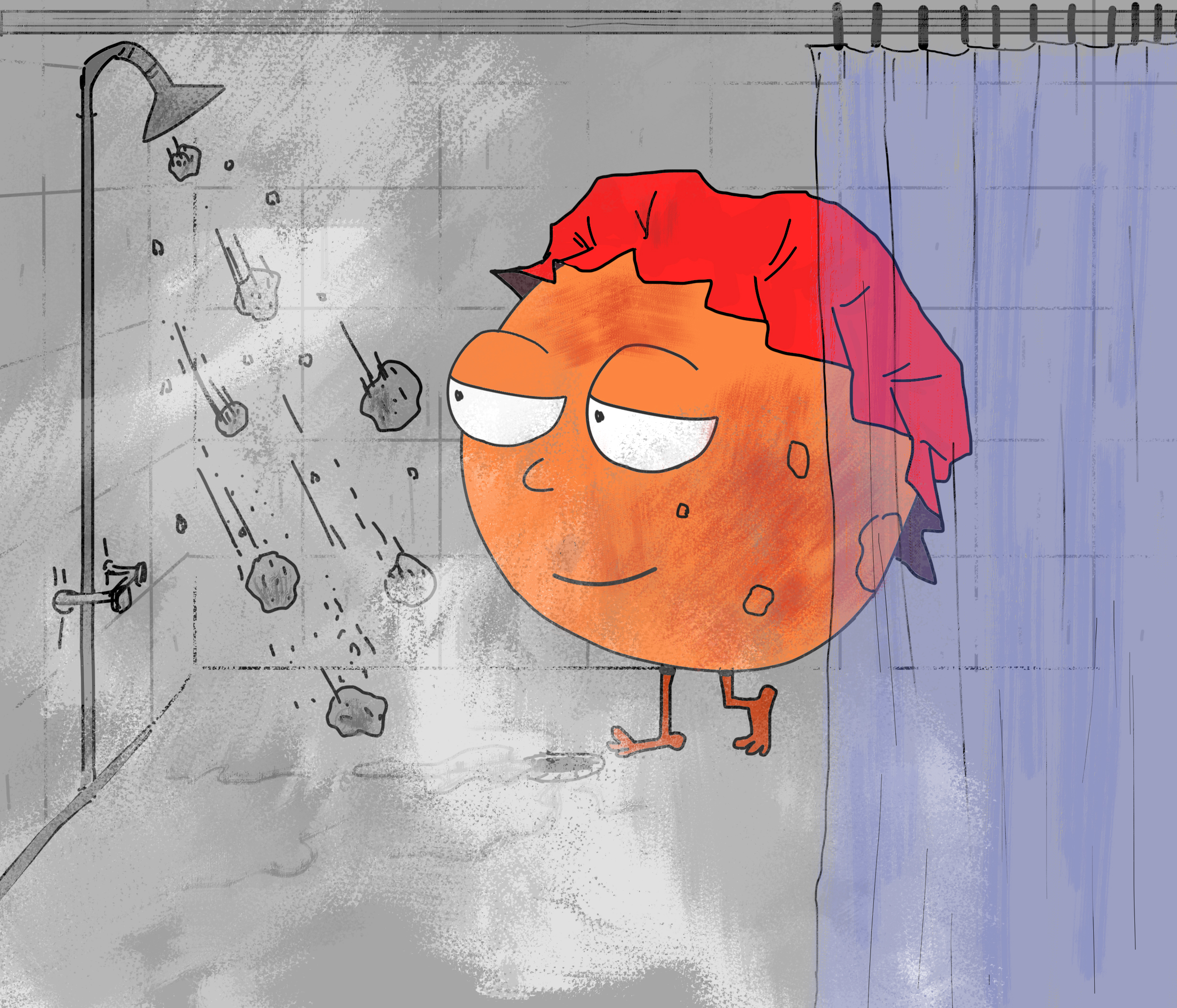Asteroids and comets appear to be a much more important supplier of organic molecules on Mars than expected. Until now, astronomers assumed that the organics on Mars mainly came from dust particles from space. Now, computer simulations by an international team of researchers led by Dutch astronomers indicate that one third of the material comes from asteroids and comets. The findings have been accepted for publication in the scientific journal Icarus.

In 2015, the Mars rover Curiosity discovered remnants of organic molecules on Mars. Scientists wondered how these organic molecules had ended up on Mars. The prevailing theory was that the molecules were tied to interplanetary dust particles. Those particles are everywhere. For example, around our earth we see the dust particles when they enter our atmosphere and cause ‘shooting stars’.
An international team of researchers from SRON Netherlands Institute for Space Research, the University of Groningen, Utrecht University and the University of California Santa Barbara, suspected that the theory of the dust particles could not be the whole story. The scientists assumed that some of the organic molecules might be delivered by asteroids and comets. To investigate this, they built a computer model of our solar system including hundreds of thousands of asteroids and comets. Then they used Peregrine, the supercomputer of the University of Groningen, to run the computer model for a few weeks.
The calculations show that 192 tons of carbon per year end up on Mars. That is comparable to 8 truckloads. Approximately 129 tons (67%) of carbon come from interplanetary dust particles. But asteroids also deliver another 50 tons per year (26%) and comets provide about 13 tons (7%) of the organic material.
The research has consequences for future and current Mars missions. Mars rovers, according to the astronomers, should look closely at the impact craters of asteroids. In those places, a lot of organic material could be found.
Furthermore, the research also has implications for the chance of life on exoplanets. The Groningen PhD student Kateryna Frantseva, who led the research, explains: “Near other stars, there are also exo-asteroids and exocomets that can shower the surfaces of exoplanets with carbon. If, on top of that, there is water, then you have the required ingredients for life.”
Now, the researchers focus on the planet Mercury, where water has been found. They want to estimate how much water on Mercury can be delivered by asteroids and comets. After that they want to extend their research to planetary systems around other stars.
Scientific paper
“Delivery of organics to Mars through asteroid and comet impacts,” Kateryna Frantseva, Michael Mueller, Inge Loes ten Kate, Floris F.S. van der Tak, Sarah Greenstreet, 2018 accepted for publication in Icarus (free preprint)
Credits for editing this webrelease go to Kateryna, her collaborators and editors at Astronomie.nl
Planetoïden en kometen overspoelen Mars met organisch materiaal
Planetoïden en kometen blijken een veel belangrijkere leverancier te zijn van organisch materiaal op Mars dan gedacht. Tot nu toe gingen astronomen ervan uit dat het organisch materiaal op Mars voornamelijk van stofdeeltjes uit de ruimte komt. Computersimulaties van een internationaal team van onderzoekers onder leiding van Nederlandse sterrenkundigen duiden er nu op dat een derde van het materiaal afkomstig is van planetoïden en kometen. De bevindingen zijn geaccepteerd voor publicatie in het wetenschappelijke tijdschrift Icarus.

In 2015 ontdekte de Marsrover Curiosity overblijfselen van organische moleculen op Mars. Wetenschappers vroegen zich af hoe die organische moleculen op Mars terecht waren gekomen. De heersende theorie was dat de moleculen waren meegelift op interplanetaire stofdeeltjes. Die deeltjes zijn overal. Rond de aarde zien we de stofdeeltjes bijvoorbeeld als ze onze atmosfeer binnendringen en voor ‘vallende sterren’ zorgen.
Een internationaal team van onderzoekers, werkzaam bij SRON Netherlands Institute for Space Research, de Rijksuniversiteit Groningen, Universiteit Utrecht en de University of California Santa Barbara, vermoedde dat de theorie van de stofdeeltjes niet het hele verhaal kon zijn. De wetenschappers dachten dat een deel van de organische moleculen best eens geleverd zou kunnen worden door planetoïden en kometen. Om dat te onderzoeken, bouwden ze een computermodel van de zon, de planeten en honderdduizenden planetoïden en kometen. Vervolgens lieten ze Peregrine, de supercomputer van de Rijksuniversiteit Groningen, een paar weken aan het computermodel rekenen.
Uit de berekeningen blijkt dat er per jaar 192 ton koolstof op Mars terechtkomt. Dat is vergelijkbaar met 8 zandwagens. Daarvan komt ongeveer 129 ton (67%) van interplanetaire stofdeeltjes. Maar planetoïden leveren ook nog eens 50 ton per jaar (26%) en kometen zorgen voor zo’n 13 ton (7%) van het organische materiaal.
Het onderzoek heeft gevolgen voor toekomstige en huidige Marsmissies. Marsrovers zouden, zo stellen de astronomen, eens goed moeten kijken in de buurt van de inslagkraters van planetoïden. Op die plekken zou namelijk heel wat organisch materiaal te vinden kunnen zijn.
Verder heeft het onderzoek ook implicaties voor de kans op leven op exoplaneten. De Groningse PhD-student Kateryna Frantseva die het onderzoek leidde, licht toe: “Bij andere sterren zijn er namelijk ook exo-planetoïden en exokometen. Die kunnen de oppervlakken van exoplaneten voorzien van koolstof. Als er dan ook nog water aanwezig is, dan heb je in ieder geval de vereiste ingrediënten voor leven.”
De onderzoekers richten hun pijlen nu op de planeet Mercurius, waar water is gevonden. Ze willen inschatten hoeveel water op Mercurius kan worden afgeleverd door planetoïden en kometen. Daarna willen ze hun onderzoek uitbreiden naar planeetstelsels rond andere sterren.
Wetenschappelijk artikel
Delivery of organics to Mars through asteroid and comet impacts. Door: Kateryna Frantseva, Michael Mueller, Inge Loes ten Kate, Floris F.S. van der Tak, Sarah Greenstreet. Geaccepteerd voor publicatie in Icarus. (gratis preprint)
Webartikel met dank aan Kateryna, haar collega’s en de redactie van Astronomie.nl


